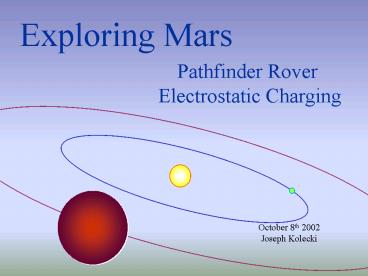Exploring Mars - PowerPoint PPT Presentation
1 / 37
Title: Exploring Mars
1
Exploring Mars
Pathfinder Rover Electrostatic Charging
.
October 8th 2002 Joseph Kolecki
2
- Preliminary Activities
- 1. What surface conditions prevail on Mars?
- Cold, dry, dusty
- Warm, dry, dusty
- Cool, wet, crusty
- All of the above
- How might the surface conditions on Mars be
related to ambient electrical activity? - Conducive
- Not conducive
- A little conducive
- Conditionally Conducive
3
- Which surface element on Mars would you think
most likely to develop and carry charge? - Rocks
- Dust
- Duracrust
- Volcanic glass
- What charging mechanisms do you believe are
operational on Mars? - Collisional charging
- Triboelectric (frictional) charging
- Photoelectric effect
- None of the above
4
- What are some issues associated with surface
vehicle and astronaut charging? - No issues
- Charge is harmless
- Charge could impact operations
- Charge could produce fatal conditions
5
(No Transcript)
6
Mars
7
Tarsus
8
Mount Olympus
9
Mariners Valley
10
Martian arroyos as seen from orbit
11
(No Transcript)
12
Fossil Martian Nano-Bacteria?
13
Why go to Mars??? Most earth-like
planet Reachable via present day
technology Possible future colonization Simple
curiosity Its there!!!
14
Why Send Robots to Mars??? Robots are more
durable/less expensive than humans. Robots can
accomplish almost as much as humans. Robots can
help us to learn as much as we can about the
Martian environment before we send humans.
15
Environmental Issues at Martian Surface Radiation
environment Chemistry Toxicity Electrical
charge Biology (?)
16
Electrical Charging in the Martian Environment
17
Why expect charging on Mars? Cold, dry climate
good for charging things up Seasonal winds
good for stirring things up Dust storms good
for keeping things stirred up in a variety of ways
18
What physical mechanisms might be
involved? Collisional charging due to turbulent
motion in dust clouds dust storms Triboelectric
charging due to vehicle or astronaut motion
across the surface Photoelectric charging due to
solar UV at the surface
19
Collisional Dust-Charge Exchange Mechanism
20
-
21
Effects of Collisional Charging in a Martian Dust
Cloud
22
Paschens Curve
Electric Potential Difference
Pressure-Distance Product
23
Paschen Curve Minimum
Electric Potential Difference
100V
Pressure-Distance Product
5 X 10-5 atm-m
24
Sojourner Rover Triboelectric charge
Frictionally generated electric charge
25
(No Transcript)
26
(No Transcript)
27
Dust collection in laboratory
28
(No Transcript)
29
(No Transcript)
30
(No Transcript)
31
Conclusions
32
Because of mass constraints on rover, no
instruments were carried to measure
charge. Instruments will be carried on future
landers and rovers to better characterize Mars
electrical environment.
33
(No Transcript)
34
(No Transcript)
35
(No Transcript)
36
Some Issues Remaining to be Solved What is the
nature of Martian surface electricity? Do
electrical discharges accompany dust storms? Dust
devils? Can these storms be detected by radio
static? Does triboelectric charging pose a hazard
to future large rovers? To future astronauts?
37
joseph.c.kolecki_at_grc.nasa.gov

